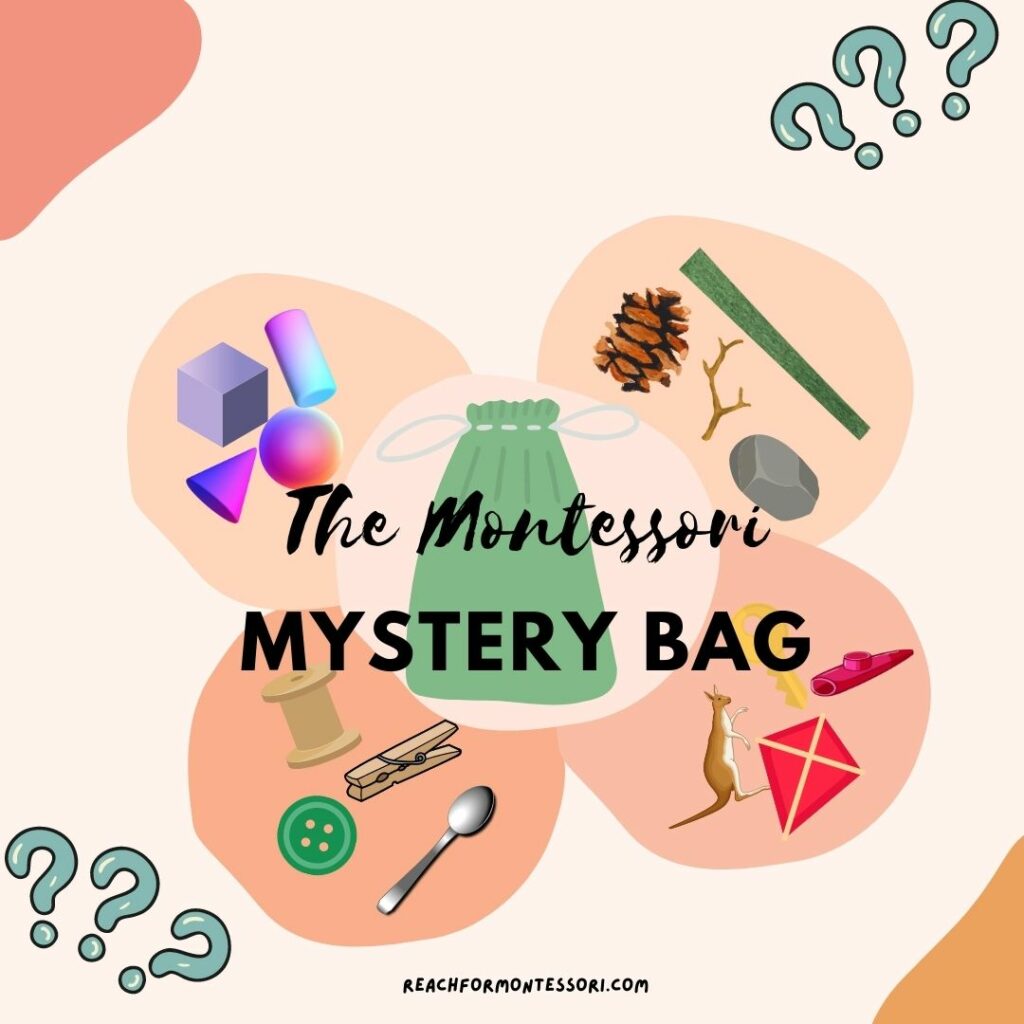If you are curious as to what the Mystery Bag in Montessori is, you have come to the right place.
Here, I'll go over what the Mystery Bag is, its purpose, and what age to present it.
I'll also cover the Mystery Bag lesson and give you some fun ideas for what to include inside one, as well as themed Mystery Bag ideas.
This is such a fun Montessori activity and I can't wait to share it with you.
Let's get right to it.

(This post contains affiliate links. Purchasing from these links costs you nothing extra, but helps with our website upkeep.)
What is a Mystery Bag?
The Mystery Bag is a cloth pouch that contains a series of small objects from their environment that children are invited to explore and identify using their senses.
The Mystery Bag is a Montessori sensorial activity and is an important part of both classroom and homeschool curricula.
Mystery Bags don't have to be a certain size. They can even be big enough for a child to feel the objects with both of their hands.
What is the purpose of the Mystery Bag in Montessori?
The purpose of the Mystery Bag is to train a young child's stereognostic sense. (It also helps refine the thermic, baric, and tactile senses.)
Stereognostic sense, one of the nine senses addressed in Montessori education, is controlled by the part of the brain called the somatosensory cortex.
This part of the brain receives sensory information and processes it to initiate an appropriate response.
An example of stereognostic sense in use:
The power goes out at night and you must find your way to your child to comfort them.
You extend your arms in front of you and you know you are at your bedroom door because you feel the door knob.
You make it all the way to your child without being able to see anything at all.
This is because your somatosensory cortex receives the information from the nerves in your hands and feet, allowing you to form a mental image of the item you are touching and where you are stepping.
When your child is engaged in a Mystery Bag activity or other stereognostic activity, they must use only their tactile sense to figure out what the objects are, thereby refining this sense.
In Montessori, sometimes the child will agree to wear a blindfold for a few moments, as an activity extension.
These extensions are also aimed at refining a child's stereognostic sense. Here are some activity examples.
Montessori Mystery Bag ideas
There are so many different ways a Mystery Bag can be used. Here are some fun ideas to get you started.
Nature Mystery Bag
Find some small items from outside, the small pinecones, sweet gumballs, large blades of grass, rocks, and twigs.
Beach Mystery Bag
Find some small beach items like shells, sea glass, and dried seaweed.
Sound Game Mystery Bag
When a child is learning letter sounds, find small items that begin with the letter sound they're working on.
Letters Mystery Bag
If you have a Small Moveable Alphabet, you can place a few of the letters in the bag and ask the child to identify them.
Pairing Activities
Place a few sets of identical objects on the bag and invite the child to make matches.
Shapes Mystery Bag
Place several different 3D shapes into the Mystery Bag and have the child identify them
What age is the stereognostic bag for?
The stereognostic bag (Mystery Bag) is introduced around the age of 3 years old.
It is used throughout the Montessori primary years.
How to present the Mystery Bag activity
If you are presenting the Mystery Bag activity in your classroom or homeschool room, it will be kept at the sensorial shelf.
So, you'd be asking the child to accompany you to the shelf and carry it to a work mat on the floor or table.
It's also fine to present the Mystery Bag lesson as a casual activity during the day, if you're not homeschooling. It's a lot of fun and young children are usually pretty excited about it.
You can even do this activity while waiting for food at a restaurant or in the waiting room at a doctor's appointment.
Note:
Be sure your child is familiar with the names of each object in the bag.
If a child seems to be overwhelmed by the activity, you can place just one or 2 items in the bag to start with.
- Take the objects out of the Mystery Bag, one by one, saying the name of each item as you remove them.
- Put all of the items back into the bag.
- Reach your hand into the bag and let the child know you have picked an object up and are now feeling to see what it is.
- Name the object.
- Remove the object from the Mystery Bag and set it down on the work mat.
- Repeat these steps until every object in the Mystery Bag has been identified and set out.
- Place the objects back in the bag and ask the child if they'd like to try the activity.
Of course, if you are presenting this in a classroom or homeschool setting, you'd have the child put the material back in its proper place and let them know that they are welcome to do the activity whenever they like.
This can be presented as a group activity after each child has worked individually with the Mystery Bag.
Have you done any Montessori Mystery Bag activities with your classroom or at home with your child that you'd like to share?
Cheers and don't forget to subscribe!
